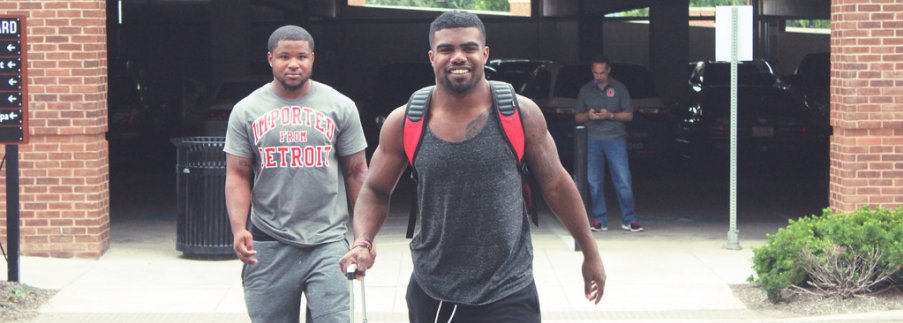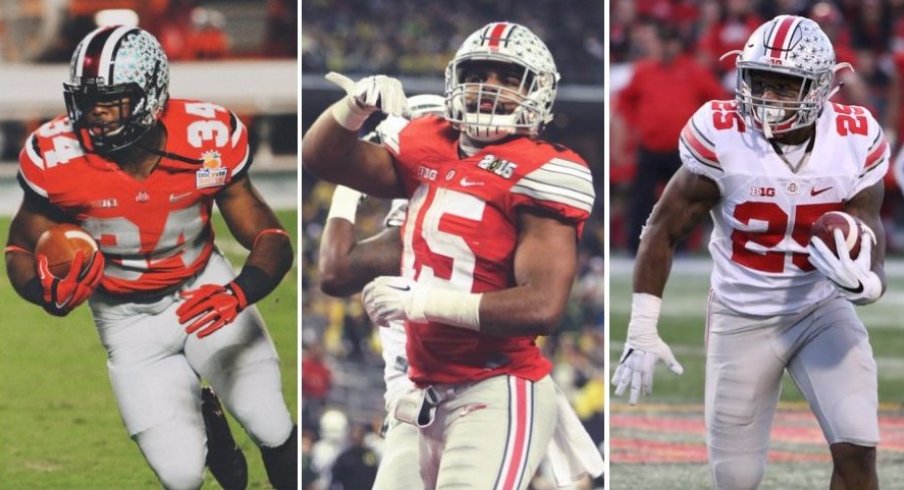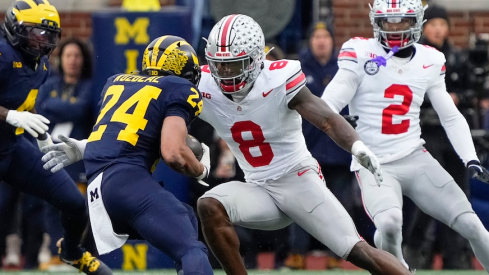Mike Weber was no slouch last year becoming just the third Ohio State freshman running back to eclipse the 1,000 rushing barrier.
That factoid, while impressive, is tired at this point and even Weber himself has long turned the page to thinking about how 2017 can be so much better than the 1,096 rushing yards and nine touchdowns recorded a season ago especially after a six game fizzle followed a seven game sizzle.
Weber's opening seven games last year yielded averages of 16.4 carries and 97.6 yards but those last six games saw his carries dwindle to 11.1 per game and by extension his rush yards plummeted to 68.8.
The now redshirt sophomore received only five carries against Clemson in the disastrous College Football Playoff semifinal (5 att, 24 yds) on the heels of 11 carries for 26 yards against Michigan.
Weber (and more than a few fans) were frustrated over the lack of touches against the Tigers but when you fumble twice, losing one, and drop an easy 3rd down conversion, I'm not sure how you can expect to be fed like The Man.
No matter, it's 2017 and Weber has designs on following the blueprint of success laid out by his predecessors in the Urban Meyer era; Carlos Hyde and Ezekiel Elliott.
Those two posted exceptional stats in Year 2 as the starting tailback at Ohio State after good (Hyde) to great (Elliott) output in Year 1.
| PLAYER | YEAR | G | ATT | R YDS | YPC | TD | ATT/G | R YDS/G | % TEAM ATT | % TEAM R YDS |
|---|---|---|---|---|---|---|---|---|---|---|
| C. HYDE | 2012 | 10 | 185 | 970 | 5.2 | 16 | 18.5 | 97.0 | 33.1% | 33.4% |
| C. HYDE | 2013 | 11 | 208 | 1,521 | 7.3 | 15 | 18.9 | 138.3 | 32.7% | 35.2% |
| E. ELLIOTT | 2014 | 15 | 273 | 1,878 | 6.9 | 18 | 18.2 | 125.2 | 39.6% | 47.3% |
| E. ELLIOTT | 2015 | 13 | 289 | 1,821 | 6.3 | 23 | 22.2 | 140.1 | 51.0% | 57.1% |
| M. WEBER | 2016 | 13 | 182 | 1,096 | 6.0 | 9 | 14.0 | 84.3 | 31.2% | 34.3% |
Hyde played just 10 games in 2012 as a first-year starter season but still nearly managed 1,000 rushing yards despite the second-fewest carries of any OSU tailback during the Meyer era, along with the weakest yards per carry.
Just missing out on averaging 100 rush yards per game, Hyde played second fiddle to Braxton Miller who tallied 227 carries for 1,271 yards (5.6 ypc) with 13 ground scores.
In year two as a starter however, Hyde, while averaging not even a half a carry more per game than he did in 2012, churned out a ridiculous 7.3 yards per tote on the way to 138.3 yards per game and 1,521 on the season.
With Hyde proving to be such a prolific weapon, Meyer was able to save Miller some hits as his carries dropped by 56, only increasing Hyde's worth to the offense.
Overall, from year one to year two, Hyde improved his total rushing yards, yards per carry, attempts per game, yards per game and percent of team rushing yards. Not bad.
With Hyde off to the NFL, Elliott seized his opportunity putting up one of the more insane statistical seasons ever turned in by an OSU running back capped by a three-game stretch to end the season that will never be duplicated. Those numbers? Try 76 carries, 696 yards and eight touchdowns which translates to 25.3 carries and 232 yards per outing.
Interestingly, Zeke's sidekick, J.T. Barrett, had exactly as many carries as Braxton in 2013 as Hyde's sidekick, though with 130 less yards.
After what Zeke did as a first-year starter, it wasn't realistic to think he would fair significantly better in his second year but in some ways, he was indeed better.

Year two saw Elliott average 6.3 yards per carry compared to 6.9 in 2014 however he registered more touchdowns (23 to 18), attempts per game (22.2 to 18.2) and yards per game (140.1 to 125.2) while accounting for a larger chunk of the team's rushing attempts (51% to 40%) and rushing yards (57% to 47%).
With Elliott off to Dallas, Weber seized the gig last season and as noted, started on a tear rushing for 100+ yards in three of the first four games only to sputter down the stretch.
When the dust settled on a successful but uneven first-year starter campaign, Weber amassed those 1,096 yards on a sturdy 6.0 yards per carry while his attempts per game (14.0) and percent of team attempts (31.2%) were easily the lowest of any starting tailback during Meyer's run in Columbus.
It didn't help that Weber put the ball on the ground a few times late in the year and with the offense struggling to find an identity, the offensive braintrust relied too heavily on Barrett in the run game (205 carries, 845 yards, 4.1 ypc) and probably not enough on H-back Curtis Samuel (97 carries, 771 yards, 7.9 ypc).
Things are different this fall however as Weber is the only established running back (hell, skill player) not named Barrett on the roster. That reality combined with Weber's own continued maturation and Kevin Wilson's desire to play uptempo all bode well for the Detroit product's expected touches.
Conversely, a potential emergence of freshman J.K. Dobbins and/or Demario McCall as legit, trusted ball carriers could subtract some attempts from Weber's workload – unless he performs so well Wilson and Meyer feel like they must reward his efforts in the form of an ever-increasing role.
Earlier this offseason, I pegged Weber as a 1,400-yard guy and I still believe it. Even if that doesn't happen however, it's hard to envision a scenario in which he doesn't improve on every single metric listed in the table above.
The time is now for Weber who would love nothing more than to have a fantastic 2017 so he can enter the NFL Draft next April.


